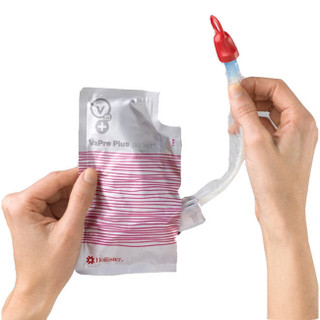Female Catheters: The Complete Guide

Female catheters are small tubes specifically designed for draining urine from the female urethra. These catheters are compact and ideal for women experiencing urinary incontinence.
Many types of urinary catheters for females are available, including straight-tip, pre-lubricated, and pocket catheters. Choosing one that best fits your body can be overwhelming and confusing. Having the right information, however, can help you clarify and streamline the process.
This product guide will cover:- Types of Female Catheters
- What to Consider When Choosing a Female Catheter
- How to Use a Female Catheter
- Female Catheter Sizing
- What Is the Difference Between Male and Female Catheters?
- Can a Woman Use a Male Catheter?
- What is Intermittent Catheterization for Females?
- Is It Painful to Self-Catheterize?
- What Female Catheter Problems Might You Experience?
- When to Call Your Doctor
Types of Female Catheters
Female catheters come in several types, each designed to support different medical needs, lifestyles, and preferences. Understanding the options can help you choose the best product for comfort, ease of use, and hygiene. Catheters are generally grouped into three main categories: intermittent catheters, indwelling (Foley) catheters, and external catheters.
Intermittent Catheters
Used for occasional bladder drainage, intermittent catheters are inserted temporarily and removed after use. Subtypes include:
- Straight Catheters: The standard in-and-out catheter, straight tip catheters are usually uncoated and require manual lubrication with sterile jelly. They are available in different lengths and French sizes.
- Hydrophilic Catheters: Designed with a special coating that becomes slippery when activated with sterile water or saline, hydrophilic catheters reduce friction for smoother insertion without the need for separate lubricant.
- Pre-lubricated Catheters: These ready-to-use catheters come pre-coated with lubrication, offering convenience and reducing the risk of contamination from handling.
- Closed System Catheters: Closed system catheters include a pre-lubricated catheter housed within a collection bag. This self-contained system allows for no-touch insertion and reduces the risk of urinary tract infections (UTIs), making them ideal for use in public or sterile settings.
- Compact (Pocket) Catheters: Compact catheters are discreet, pre-lubricated, and easy to carry. They're designed for women who need a portable solution, often featuring designs that can be used and disposed of with minimal handling. Popular options include Coloplast SpeediCath Compact Plus and Hollister VaPro Plus Pocket.
Indwelling Catheters (Foley Catheters)
Foley catheters are inserted and left in place for extended periods, typically secured with a small balloon inside the bladder. These are often used in hospitals or for long-term care situations and must be managed with care to prevent infections.
External Catheters
External catheters for women, such as PureWick™ or urinary pouches, are placed outside the body to collect urine without insertion into the urethra. These are non-invasive and often used for nighttime incontinence or when insertion is not possible.
What to Consider When Choosing a Female Catheter
- Length: Female catheters are typically shorter than male catheters, but standard-length (around 16 inches) options are also available depending on preference and ease of use.
- French Size: Refers to the catheter’s diameter. Choosing the right French size is essential for comfort and effective drainage.
- Materials: Most catheters are made of latex-free materials such as silicone or PVC, reducing the risk of allergic reactions.
- Coude Tip vs. Straight Tip: While most female catheters use a straight tip, coude tips (curved) may be recommended for navigating around obstructions or for users with certain medical conditions.
- Ease of Use: Pre-lubricated and closed systems offer convenience and reduce contamination risk.
- Hygiene: No-touch systems and external catheters reduce the risk of infection and are easier to use in less sanitary environments.
How to Use a Female Catheter
Prior to using any female catheter, read the manufacturer’s instructions carefully and contact your healthcare professional, treating physician, or nurse with any questions.
Before you self-catheterize, ensure that you have all the necessary supplies on hand. For most women, these include the catheter, sterile lubricating jelly, cleaning wipe/towelette, and a container to collect the urine if a toilet is not available.
Here are some simple steps that will help make the self-catheterization process much easier:
- Wash your hands thoroughly with soap and water. If you prefer, you may also use disposable gloves.
- Ensure that your genital area is clean and dry. You can clean your labia using a baby wipe or antiseptic towelette.
- Peel back the paper side of the catheter packet without touching the catheter.
- If you are using a non-lubricated catheter, apply lubricating jelly to the top 2 inches of the device.
- Gently fold back the labia and locate the urethral opening (You may also use a mirror to help with this process).
- Holding your labia with one hand, use your other hand to gently slide the catheter up into the urethra until urine begins to flow.
- Let the urine drain into the toilet or container.
- Once the urine flow has stopped, place a finger over the end of the tube and remove the catheter.
- You can dispose of the used catheter in the normal trash. Never flush the device down the toilet.
It is important to never force the catheter if it feels stuck. Instead, remove the device, take a few deep breaths, and try again.
Female Catheter Sizing
A female catheter tube is typically between 5 and 8 inches long, however, intermittent catheters often have their diameters measured in French sizes. One French unit (Fr) equals 0.013 inches or 0.33mm.
In general, female intermittent urinary catheters fall in the 8Fr to 16Fr range. The higher this number, the larger the catheter’s diameter.
What Is the Difference Between Male and Female Catheters?
The primary difference between male vs female catheters is their length. Male catheters are generally 16 inches long to accommodate the longer male urethra, while female catheters are shorter, typically around 6 to 8 inches. Aside from length, both types may come in similar materials, styles (such as straight tip or coude tip), and features like hydrophilic coatings or closed systems. While women can usually use either length, men should not use female-length catheters, as they are too short to safely reach the bladder. Choosing the correct length is important for effective and safe catheterization.
Can a Woman Use a Male Catheter?
Yes, a woman can use a male catheter. Male catheters are typically about 16 inches long, while female catheters are shorter—usually 6 to 8 inches—because the female urethra is much shorter. Some women may find that using a longer, male-length catheter provides easier handling or better control, especially when self-catheterizing. However, the longer length isn’t medically necessary for women and may feel less comfortable for some. Always consult a healthcare provider when choosing the right catheter type and length to ensure safety and comfort.
What is Intermittent Catheterization for Females?
A female catheter is a type of intermittent catheter. Intermittent self-catheterization (ISC) is the process of inserting and removing a urinary catheter to empty the bladder at regular intervals throughout the day. ISC may be required due to urinary retention, incontinence, and spinal cord injuries.
Intermittent catheters are small flexible tubes used to drain urine from the bladder. They are typically inserted through a urethra or a stoma. Intermittent catheters are designed for single-use only and are usually made of red rubber latex, PVC, or silicone.
As the female urethra is only a few inches long, female intermittent catheters are significantly shorter than standard 16-inch catheters, varying between 5 and 8 inches in length.
Is It Painful to Self Catheterize?
At the start, self-catheterization may cause slight pain. If you experience discomfort while inserting your catheter, take some time to relax before trying again.
For some people, the entire process of self-catheterization may be uncomfortable and painful. Trying different products and techniques, however, often helps to reduce discomfort.
What Female Catheter Problems You May Have
Though the right product and technique can make self-catheterization more comfortable, there are still a few problems that can occur during the process.
No Urine Flow from the Catheter
A lack of urine flow is one of the most common complaints from new female intermittent catheters. Use a magnifying mirror to ensure your catheter is inserted in your urethra and not in the vagina.
If you inserted the catheter in the vagina, simply remove it and insert a new, clean catheter into the urethral opening. If the catheter is in the urethra but there is still no urine production, gently push the tube further up into the urethral opening.
Urine Leakage
Urine leaks are another frequent issue. If you notice urine leaks during intercourse or between catheterizations, it may simply come down to drinking extra liquids. Urine leaks, however, can also be a sign of a bladder infection.
If you suspect an infection, contact your treating physician as soon as possible.
To avoid urine leaks during sexual activity, try to limit your amount of liquids and catheterize before intercourse.
Blood in the Urine or on the Catheter
Blood in the urine when self-cathing is not an uncommon symptom. If you notice blood on the catheter, this may indicate that your urethra is too dry. Use more lubricating jelly to help prevent friction and irritation.
Blood in the urine could be a sign of a urinary tract infection (UTI), which should be reported to your doctor.
If you experience heavy bleeding – or if you notice blood clots – seek medical help right away.
When to Call Your Doctor
Intermittent catheters give you the opportunity to control your bladder. It is crucial, however, to monitor for certain signs and symptoms. Always notify your doctor or healthcare provider if you notice that your urine is cloudy, has a strong odor, and/or appears pink or red. Take notice of any burning sensation or pain in your abdomen, urethra, or bladder, all signs of a UTI.
Buying the Right Female Catheter
Female intermittent catheters allow you to control your bladder without needing a catheter permanently in your bladder. Self-catheterization also keeps the bladder from stretching and lowers the chances of infection.
Whether you prefer the classic straight or pre-lubricated version, Express Medical Supply offers the widest variety of female catheters and medical supplies. Find the products that suit you best and have them quickly and discreetly delivered to your doorstep.
Learn more about the different types of catheters and self-cathing accessories in our blog!




